torque SKODA SUPERB 2014 2.G / (B6/3T) Owner's Manual
[x] Cancel search | Manufacturer: SKODA, Model Year: 2014, Model line: SUPERB, Model: SKODA SUPERB 2014 2.G / (B6/3T)Pages: 246, PDF Size: 17.16 MB
Page 7 of 246
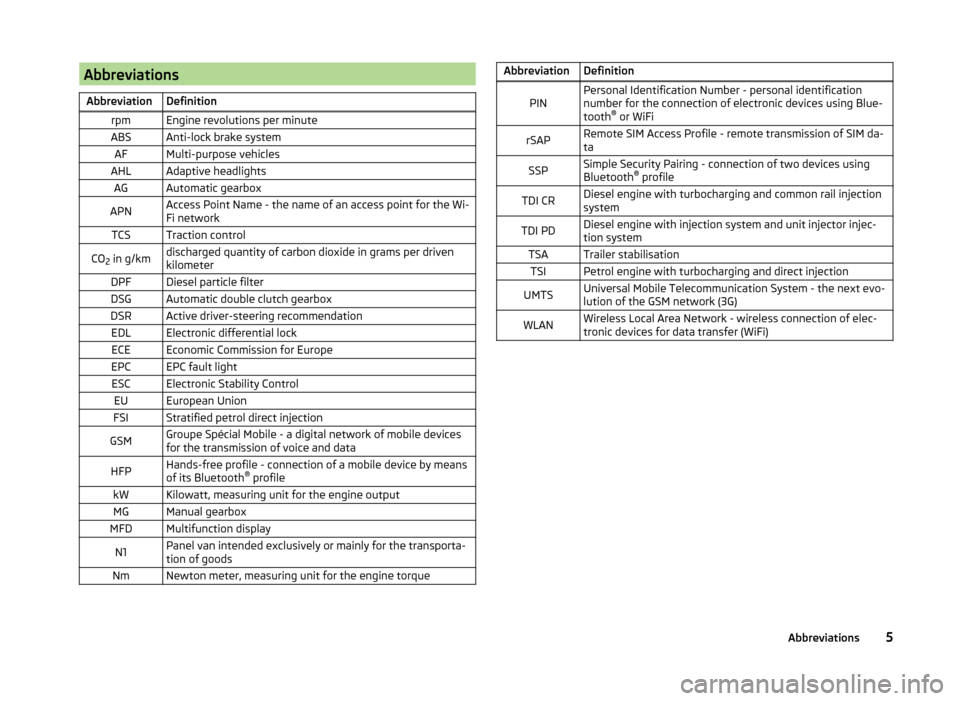
AbbreviationsAbbreviationDefinitionrpmEngine revolutions per minuteABSAnti-lock brake systemAFMulti-purpose vehiclesAHLAdaptive headlightsAGAutomatic gearboxAPNAccess Point Name - the name of an access point for the Wi-
Fi networkTCSTraction controlCO 2 in g/kmdischarged quantity of carbon dioxide in grams per driven
kilometerDPFDiesel particle filterDSGAutomatic double clutch gearboxDSRActive driver-steering recommendationEDLElectronic differential lockECEEconomic Commission for EuropeEPCEPC fault lightESCElectronic Stability ControlEUEuropean UnionFSIStratified petrol direct injectionGSMGroupe Spécial Mobile - a digital network of mobile devices
for the transmission of voice and dataHFPHands-free profile - connection of a mobile device by means
of its Bluetooth ®
profilekWKilowatt, measuring unit for the engine outputMGManual gearboxMFDMultifunction displayN1Panel van intended exclusively or mainly for the transporta-
tion of goodsNmNewton meter, measuring unit for the engine torqueAbbreviationDefinitionPINPersonal Identification Number - personal identification
number for the connection of electronic devices using Blue-
tooth ®
or WiFirSAPRemote SIM Access Profile - remote transmission of SIM da-
taSSPSimple Security Pairing - connection of two devices using
Bluetooth ®
profileTDI CRDiesel engine with turbocharging and common rail injection
systemTDI PDDiesel engine with injection system and unit injector injec-
tion systemTSATrailer stabilisationTSIPetrol engine with turbocharging and direct injectionUMTSUniversal Mobile Telecommunication System - the next evo-
lution of the GSM network (3G)WLANWireless Local Area Network - wireless connection of elec-
tronic devices for data transfer (WiFi)5Abbreviations
Page 196 of 246
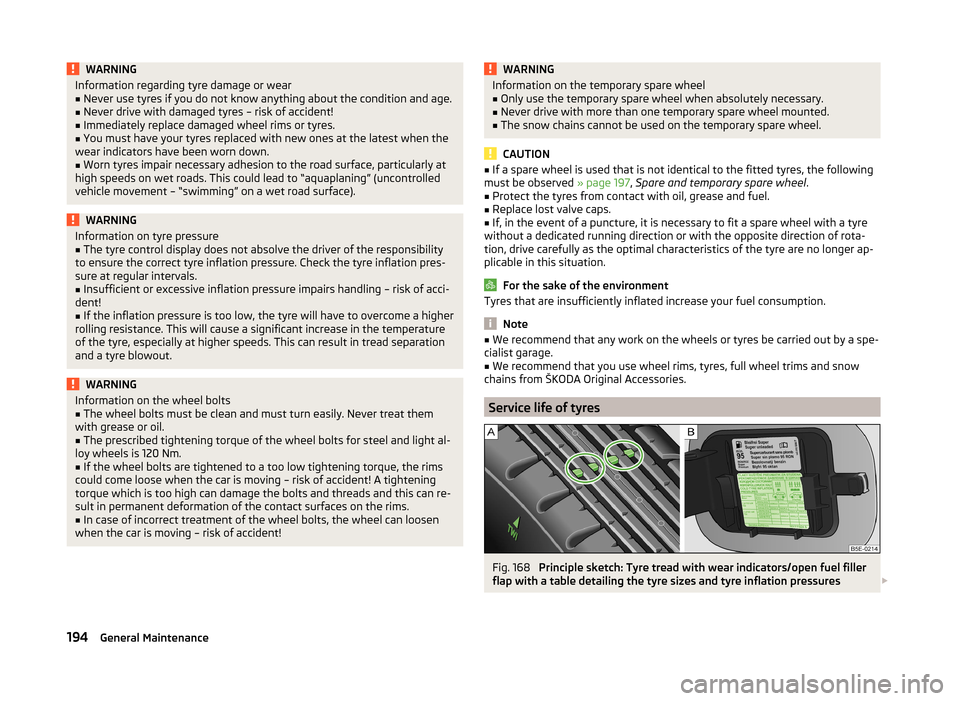
WARNINGInformation regarding tyre damage or wear■Never use tyres if you do not know anything about the condition and age.■
Never drive with damaged tyres – risk of accident!
■
Immediately replace damaged wheel rims or tyres.
■
You must have your tyres replaced with new ones at the latest when the
wear indicators have been worn down.
■
Worn tyres impair necessary adhesion to the road surface, particularly at
high speeds on wet roads. This could lead to “aquaplaning” (uncontrolled
vehicle movement – “swimming” on a wet road surface).
WARNINGInformation on tyre pressure■The tyre control display does not absolve the driver of the responsibility
to ensure the correct tyre inflation pressure. Check the tyre inflation pres-
sure at regular intervals.■
Insufficient or excessive inflation pressure impairs handling – risk of acci-
dent!
■
If the inflation pressure is too low, the tyre will have to overcome a higher
rolling resistance. This will cause a significant increase in the temperature
of the tyre, especially at higher speeds. This can result in tread separation
and a tyre blowout.
WARNINGInformation on the wheel bolts■The wheel bolts must be clean and must turn easily. Never treat them
with grease or oil.■
The prescribed tightening torque of the wheel bolts for steel and light al-
loy wheels is 120 Nm.
■
If the wheel bolts are tightened to a too low tightening torque, the rims
could come loose when the car is moving – risk of accident! A tightening
torque which is too high can damage the bolts and threads and this can re-
sult in permanent deformation of the contact surfaces on the rims.
■
In case of incorrect treatment of the wheel bolts, the wheel can loosen
when the car is moving – risk of accident!
WARNINGInformation on the temporary spare wheel■Only use the temporary spare wheel when absolutely necessary.■
Never drive with more than one temporary spare wheel mounted.
■
The snow chains cannot be used on the temporary spare wheel.
CAUTION
■ If a spare wheel is used that is not identical to the fitted tyres, the following
must be observed » page 197, Spare and temporary spare wheel .■
Protect the tyres from contact with oil, grease and fuel.
■
Replace lost valve caps.
■
If, in the event of a puncture, it is necessary to fit a spare wheel with a tyre
without a dedicated running direction or with the opposite direction of rota-
tion, drive carefully as the optimal characteristics of the tyre are no longer ap-
plicable in this situation.
For the sake of the environment
Tyres that are insufficiently inflated increase your fuel consumption.
Note
■ We recommend that any work on the wheels or tyres be carried out by a spe-
cialist garage.■
We recommend that you use wheel rims, tyres, full wheel trims and snow
chains from ŠKODA Original Accessories.
Service life of tyres
Fig. 168
Principle sketch: Tyre tread with wear indicators/open fuel filler
flap with a table detailing the tyre sizes and tyre inflation pressures
194General Maintenance
Page 204 of 246
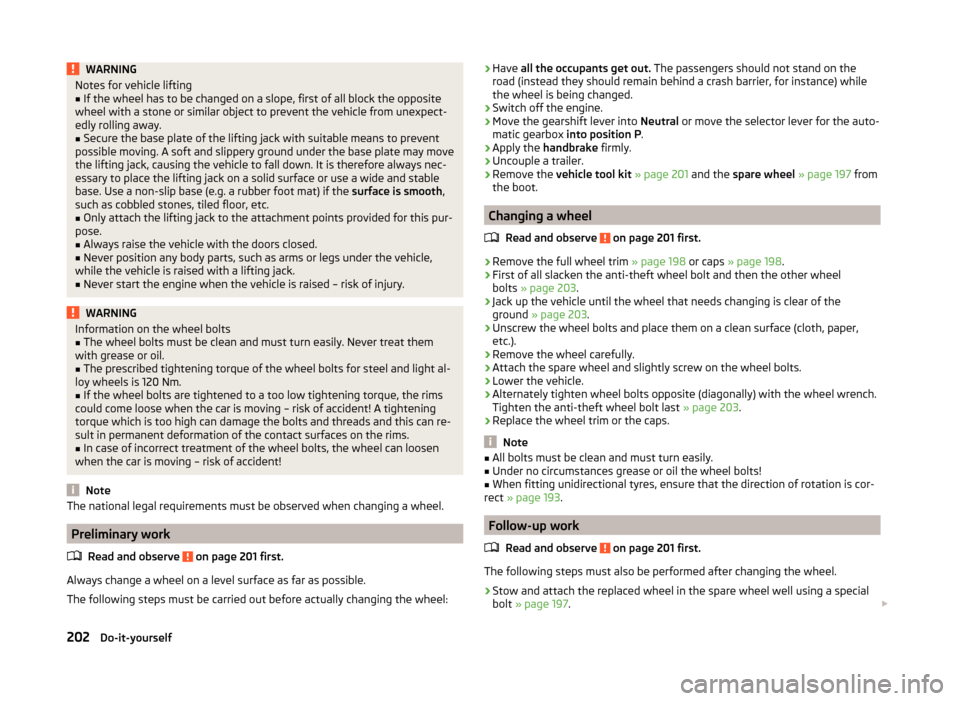
WARNINGNotes for vehicle lifting■If the wheel has to be changed on a slope, first of all block the opposite
wheel with a stone or similar object to prevent the vehicle from unexpect-
edly rolling away.■
Secure the base plate of the lifting jack with suitable means to prevent
possible moving. A soft and slippery ground under the base plate may move
the lifting jack, causing the vehicle to fall down. It is therefore always nec-
essary to place the lifting jack on a solid surface or use a wide and stable
base. Use a non-slip base (e.g. a rubber foot mat) if the surface is smooth,
such as cobbled stones, tiled floor, etc.
■
Only attach the lifting jack to the attachment points provided for this pur-
pose.
■
Always raise the vehicle with the doors closed.
■
Never position any body parts, such as arms or legs under the vehicle,
while the vehicle is raised with a lifting jack.
■
Never start the engine when the vehicle is raised – risk of injury.
WARNINGInformation on the wheel bolts■The wheel bolts must be clean and must turn easily. Never treat them
with grease or oil.■
The prescribed tightening torque of the wheel bolts for steel and light al-
loy wheels is 120 Nm.
■
If the wheel bolts are tightened to a too low tightening torque, the rims
could come loose when the car is moving – risk of accident! A tightening
torque which is too high can damage the bolts and threads and this can re-
sult in permanent deformation of the contact surfaces on the rims.
■
In case of incorrect treatment of the wheel bolts, the wheel can loosen
when the car is moving – risk of accident!
Note
The national legal requirements must be observed when changing a wheel.
Preliminary work
Read and observe
on page 201 first.
Always change a wheel on a level surface as far as possible.
The following steps must be carried out before actually changing the wheel:
› Have
all the occupants get out. The passengers should not stand on the
road (instead they should remain behind a crash barrier, for instance) while
the wheel is being changed.›
Switch off the engine.
›
Move the gearshift lever into Neutral or move the selector lever for the auto-
matic gearbox into position P .
›
Apply the handbrake firmly.
›
Uncouple a trailer.
›
Remove the vehicle tool kit » page 201 and the spare wheel » page 197 from
the boot.
Changing a wheel
Read and observe
on page 201 first.
›
Remove the full wheel trim » page 198 or caps » page 198 .
›
First of all slacken the anti-theft wheel bolt and then the other wheel
bolts » page 203 .
›
Jack up the vehicle until the wheel that needs changing is clear of the
ground » page 203 .
›
Unscrew the wheel bolts and place them on a clean surface (cloth, paper,
etc.).
›
Remove the wheel carefully.
›
Attach the spare wheel and slightly screw on the wheel bolts.
›
Lower the vehicle.
›
Alternately tighten wheel bolts opposite (diagonally) with the wheel wrench.
Tighten the anti-theft wheel bolt last » page 203.
›
Replace the wheel trim or the caps.
Note
■
All bolts must be clean and must turn easily.■Under no circumstances grease or oil the wheel bolts!■
When fitting unidirectional tyres, ensure that the direction of rotation is cor-
rect » page 193 .
Follow-up work
Read and observe
on page 201 first.
The following steps must also be performed after changing the wheel.
›
Stow and attach the replaced wheel in the spare wheel well using a special
bolt » page 197 .
202Do-it-yourself
Page 205 of 246
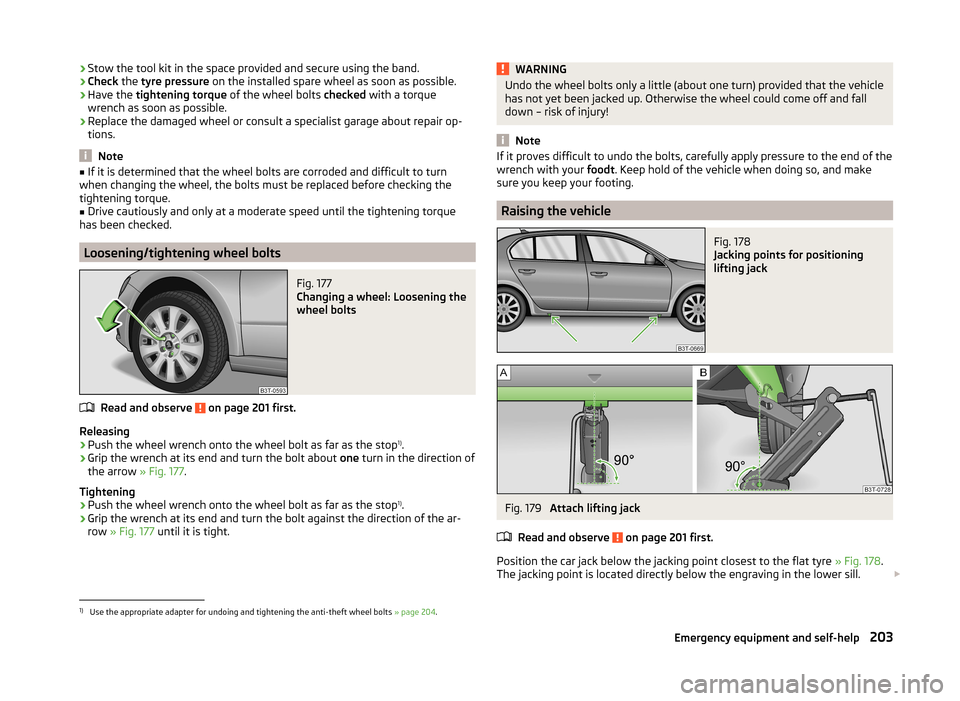
›Stow the tool kit in the space provided and secure using the band.›Check
the tyre pressure on the installed spare wheel as soon as possible.›
Have the tightening torque of the wheel bolts checked with a torque
wrench as soon as possible.
›
Replace the damaged wheel or consult a specialist garage about repair op-
tions.
Note
■ If it is determined that the wheel bolts are corroded and difficult to turn
when changing the wheel, the bolts must be replaced before checking the
tightening torque.■
Drive cautiously and only at a moderate speed until the tightening torque
has been checked.
Loosening/tightening wheel bolts
Fig. 177
Changing a wheel: Loosening the
wheel bolts
Read and observe on page 201 first.
Releasing
›
Push the wheel wrench onto the wheel bolt as far as the stop 1)
.
›
Grip the wrench at its end and turn the bolt about one turn in the direction of
the arrow » Fig. 177.
Tightening
›
Push the wheel wrench onto the wheel bolt as far as the stop 1)
.
›
Grip the wrench at its end and turn the bolt against the direction of the ar-
row » Fig. 177 until it is tight.
WARNINGUndo the wheel bolts only a little (about one turn) provided that the vehicle
has not yet been jacked up. Otherwise the wheel could come off and fall
down – risk of injury!
Note
If it proves difficult to undo the bolts, carefully apply pressure to the end of the
wrench with your foodt. Keep hold of the vehicle when doing so, and make
sure you keep your footing.
Raising the vehicle
Fig. 178
Jacking points for positioning
lifting jack
Fig. 179
Attach lifting jack
Read and observe
on page 201 first.
Position the car jack below the jacking point closest to the flat tyre » Fig. 178.
The jacking point is located directly below the engraving in the lower sill.
1)
Use the appropriate adapter for undoing and tightening the anti-theft wheel bolts
» page 204.
203Emergency equipment and self-help
Page 206 of 246
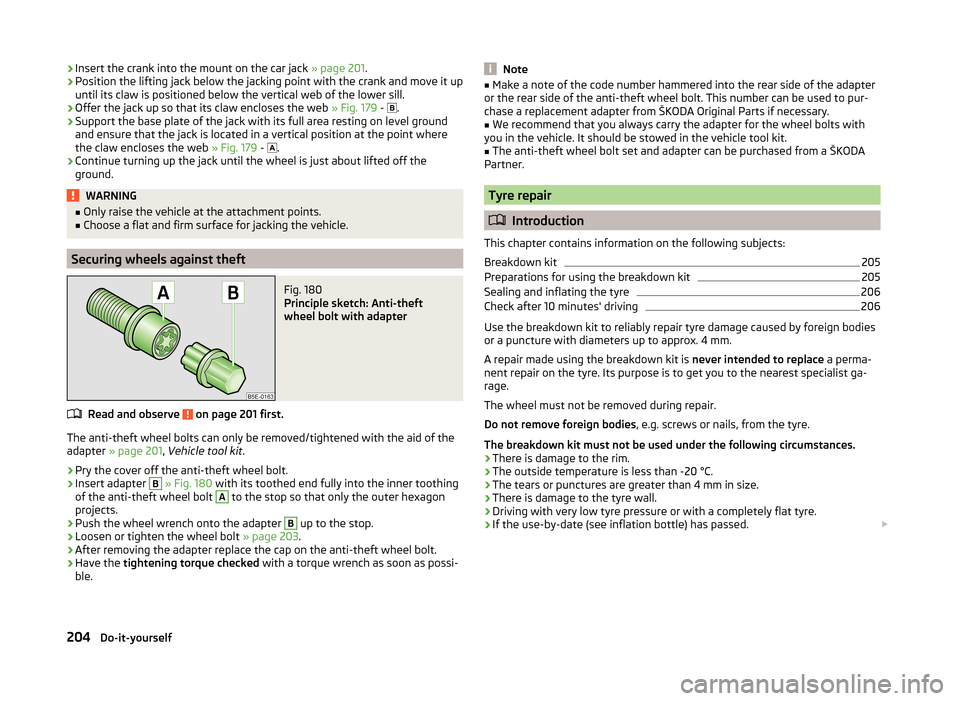
›Insert the crank into the mount on the car jack
» page 201.›Position the lifting jack below the jacking point with the crank and move it up
until its claw is positioned below the vertical web of the lower sill.›
Offer the jack up so that its claw encloses the web » Fig. 179 -
.
›
Support the base plate of the jack with its full area resting on level ground
and ensure that the jack is located in a vertical position at the point where
the claw encloses the web » Fig. 179 -
.
›
Continue turning up the jack until the wheel is just about lifted off the
ground.
WARNING■ Only raise the vehicle at the attachment points.■Choose a flat and firm surface for jacking the vehicle.
Securing wheels against theft
Fig. 180
Principle sketch: Anti-theft
wheel bolt with adapter
Read and observe on page 201 first.
The anti-theft wheel bolts can only be removed/tightened with the aid of the
adapter » page 201 , Vehicle tool kit .
›
Pry the cover off the anti-theft wheel bolt.
›
Insert adapter
B
» Fig. 180 with its toothed end fully into the inner toothing
of the anti-theft wheel bolt
A
to the stop so that only the outer hexagon
projects.
›
Push the wheel wrench onto the adapter
B
up to the stop.
›
Loosen or tighten the wheel bolt » page 203.
›
After removing the adapter replace the cap on the anti-theft wheel bolt.
›
Have the tightening torque checked with a torque wrench as soon as possi-
ble.
Note■ Make a note of the code number hammered into the rear side of the adapter
or the rear side of the anti-theft wheel bolt. This number can be used to pur-
chase a replacement adapter from ŠKODA Original Parts if necessary.■
We recommend that you always carry the adapter for the wheel bolts with
you in the vehicle. It should be stowed in the vehicle tool kit.
■
The anti-theft wheel bolt set and adapter can be purchased from a ŠKODA
Partner.
Tyre repair
Introduction
This chapter contains information on the following subjects:
Breakdown kit
205
Preparations for using the breakdown kit
205
Sealing and inflating the tyre
206
Check after 10 minutes' driving
206
Use the breakdown kit to reliably repair tyre damage caused by foreign bodies
or a puncture with diameters up to approx. 4 mm.
A repair made using the breakdown kit is never intended to replace a perma-
nent repair on the tyre. Its purpose is to get you to the nearest specialist ga-
rage.
The wheel must not be removed during repair.
Do not remove foreign bodies , e.g. screws or nails, from the tyre.
The breakdown kit must not be used under the following circumstances. › There is damage to the rim.
› The outside temperature is less than -20 °C.
› The tears or punctures are greater than 4 mm in size.
› There is damage to the tyre wall.
› Driving with very low tyre pressure or with a completely flat tyre.
› If the use-by-date (see inflation bottle) has passed.
204Do-it-yourself
Page 229 of 246
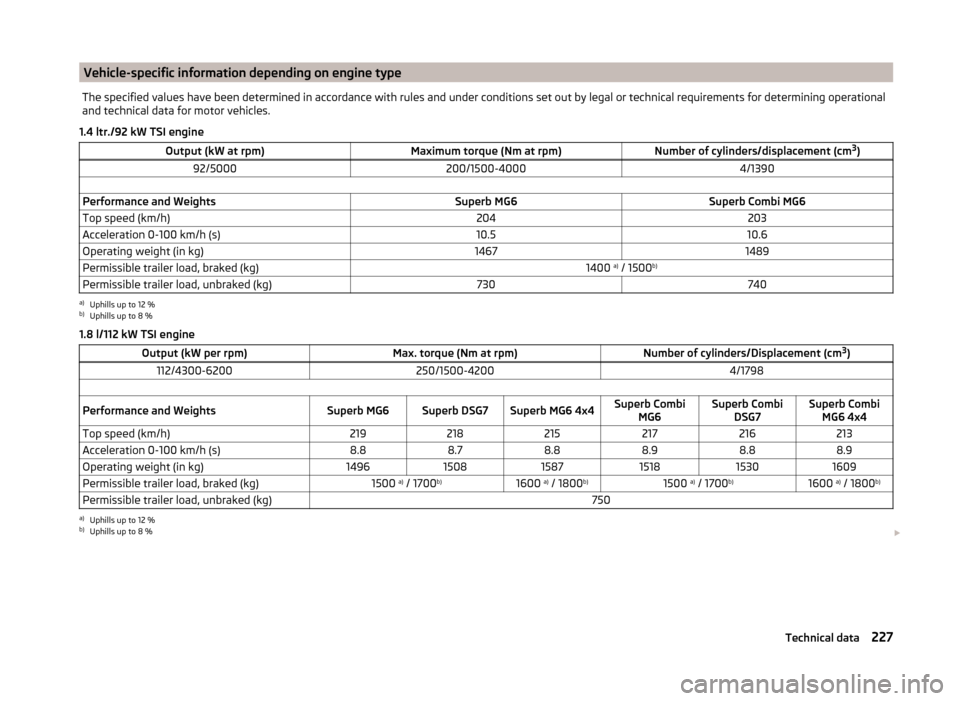
Vehicle-specific information depending on engine typeThe specified values have been determined in accordance with rules and under conditions set out by legal or technical requirements for determining operational
and technical data for motor vehicles.
1.4 ltr./92 kW TSI engine
Output (kW at rpm)Maximum torque (Nm at rpm)Number of cylinders/displacement (cm 3
)92/5000200/1500-40004/1390 Performance and WeightsSuperb MG6Superb Combi MG6Top speed (km/h)204203Acceleration 0-100 km/h (s)10.510.6Operating weight (in kg)14671489Permissible trailer load, braked (kg)1400 a)
/ 1500 b)Permissible trailer load, unbraked (kg)730740a)
Uphills up to 12 %
b)
Uphills up to 8 %
1.8 l/112 kW TSI engine
Output (kW per rpm)Max. torque (Nm at rpm)Number of cylinders/Displacement (cm 3
)112/4300-6200250/1500-42004/1798 Performance and WeightsSuperb MG6Superb DSG7Superb MG6 4x4Superb Combi
MG6Superb CombiDSG7Superb CombiMG6 4x4Top speed (km/h)219218215217216213Acceleration 0-100 km/h (s)8.88.78.88.98.88.9Operating weight (in kg)149615081587151815301609Permissible trailer load, braked (kg)1500 a)
/ 1700 b)1600 a)
/ 1800 b)1500 a)
/ 1700 b)1600 a)
/ 1800 b)Permissible trailer load, unbraked (kg)750a)
Uphills up to 12 %
b)
Uphills up to 8 %
227Technical data
Page 230 of 246
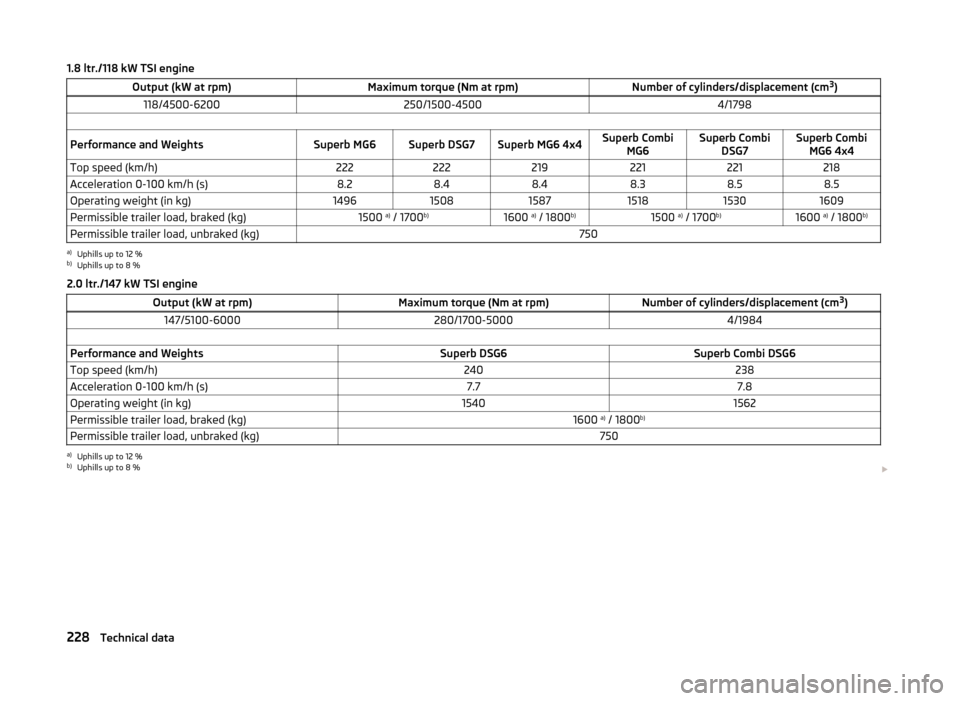
1.8 ltr./118 kW TSI engineOutput (kW at rpm)Maximum torque (Nm at rpm)Number of cylinders/displacement (cm3
)118/4500-6200250/1500-45004/1798 Performance and WeightsSuperb MG6Superb DSG7Superb MG6 4x4Superb Combi
MG6Superb CombiDSG7Superb CombiMG6 4x4Top speed (km/h)222222219221221218Acceleration 0-100 km/h (s)8.28.48.48.38.58.5Operating weight (in kg)149615081587151815301609Permissible trailer load, braked (kg)1500 a)
/ 1700 b)1600 a)
/ 1800 b)1500 a)
/ 1700 b)1600 a)
/ 1800 b)Permissible trailer load, unbraked (kg)750a)
Uphills up to 12 %
b)
Uphills up to 8 %
2.0 ltr./147 kW TSI engine
Output (kW at rpm)Maximum torque (Nm at rpm)Number of cylinders/displacement (cm 3
)147/5100-6000280/1700-50004/1984 Performance and WeightsSuperb DSG6Superb Combi DSG6Top speed (km/h)240238Acceleration 0-100 km/h (s)7.77.8Operating weight (in kg)15401562Permissible trailer load, braked (kg)1600 a)
/ 1800 b)Permissible trailer load, unbraked (kg)750a)
Uphills up to 12 %
b)
Uphills up to 8 %
228Technical data
Page 231 of 246
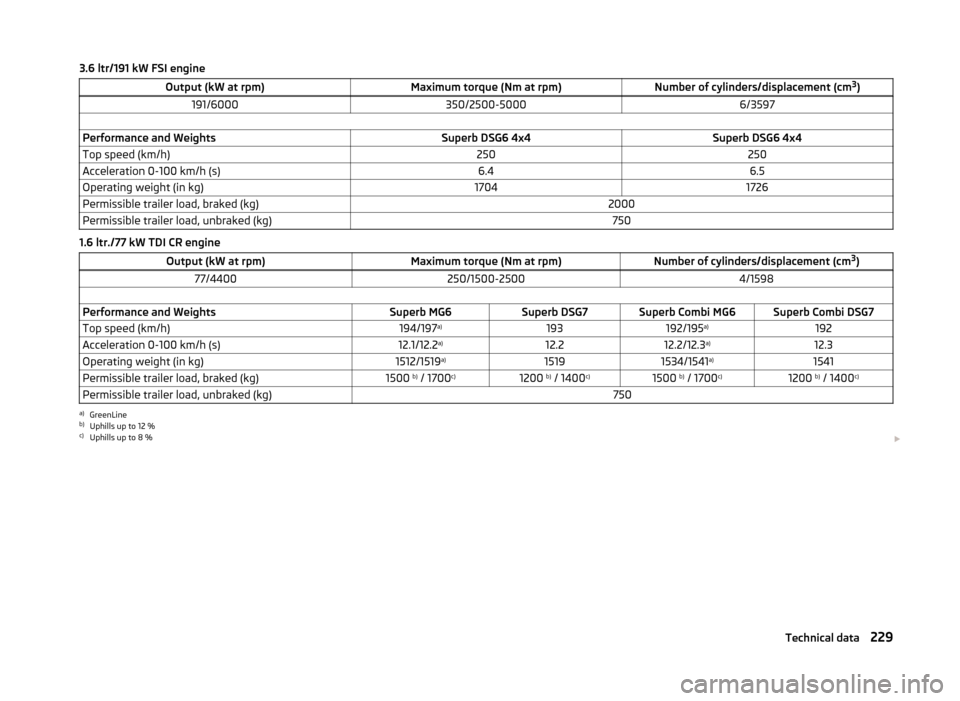
3.6 ltr/191 kW FSI engineOutput (kW at rpm)Maximum torque (Nm at rpm)Number of cylinders/displacement (cm3
)191/6000350/2500-50006/3597 Performance and WeightsSuperb DSG6 4x4Superb DSG6 4x4Top speed (km/h)250250Acceleration 0-100 km/h (s)6.46.5Operating weight (in kg)17041726Permissible trailer load, braked (kg)2000Permissible trailer load, unbraked (kg)750
1.6 ltr./77 kW TDI CR engine
Output (kW at rpm)Maximum torque (Nm at rpm)Number of cylinders/displacement (cm 3
)77/4400250/1500-25004/1598 Performance and WeightsSuperb MG6Superb DSG7Superb Combi MG6Superb Combi DSG7Top speed (km/h)194/197 a)193192/195a)192Acceleration 0-100 km/h (s)12.1/12.2 a)12.212.2/12.3 a)12.3Operating weight (in kg)1512/1519 a)15191534/1541 a)1541Permissible trailer load, braked (kg)1500 b)
/ 1700 c)1200 b)
/ 1400 c)1500 b)
/ 1700 c)1200 b)
/ 1400 c)Permissible trailer load, unbraked (kg)750a)
GreenLine
b)
Uphills up to 12 %
c)
Uphills up to 8 %
229Technical data
Page 232 of 246
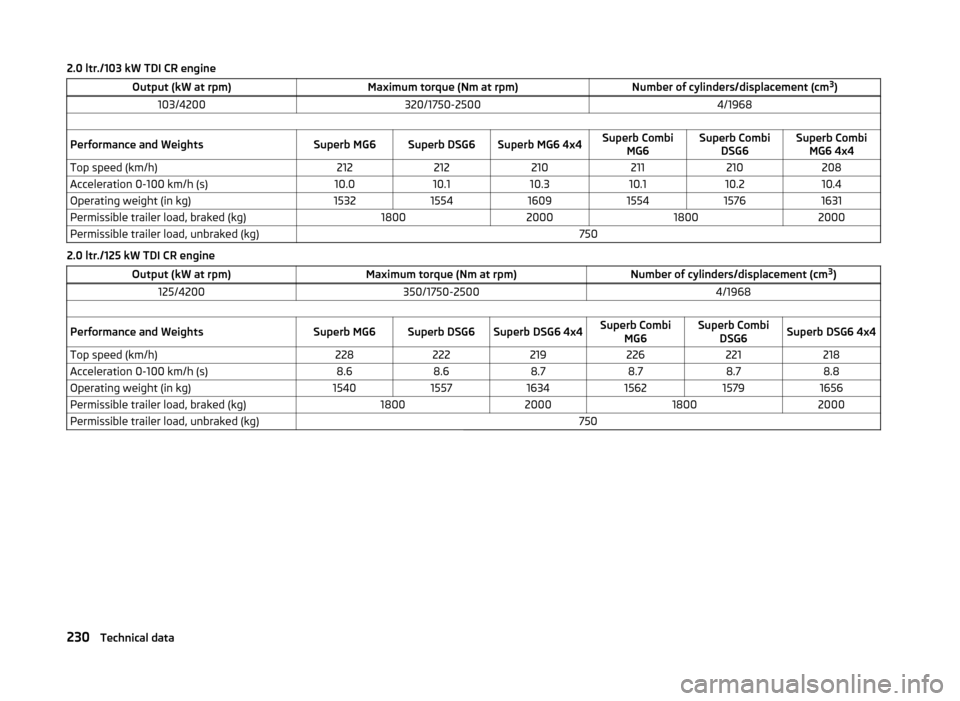
2.0 ltr./103 kW TDI CR engineOutput (kW at rpm)Maximum torque (Nm at rpm)Number of cylinders/displacement (cm3
)103/4200320/1750-25004/1968 Performance and WeightsSuperb MG6Superb DSG6Superb MG6 4x4Superb Combi
MG6Superb CombiDSG6Superb CombiMG6 4x4Top speed (km/h)212212210211210208Acceleration 0-100 km/h (s)10.010.110.310.110.210.4Operating weight (in kg)153215541609155415761631Permissible trailer load, braked (kg)1800200018002000Permissible trailer load, unbraked (kg)750
2.0 ltr./125 kW TDI CR engine
Output (kW at rpm)Maximum torque (Nm at rpm)Number of cylinders/displacement (cm 3
)125/4200350/1750-25004/1968 Performance and WeightsSuperb MG6Superb DSG6Superb DSG6 4x4Superb Combi
MG6Superb CombiDSG6Superb DSG6 4x4Top speed (km/h)228222219226221218Acceleration 0-100 km/h (s)8.68.68.78.78.78.8Operating weight (in kg)154015571634156215791656Permissible trailer load, braked (kg)1800200018002000Permissible trailer load, unbraked (kg)750230Technical data